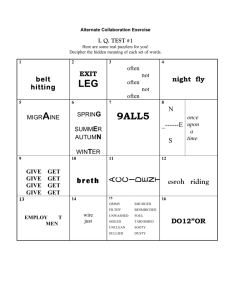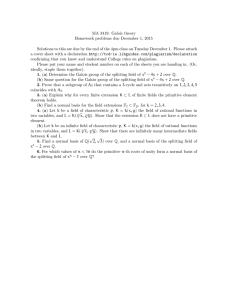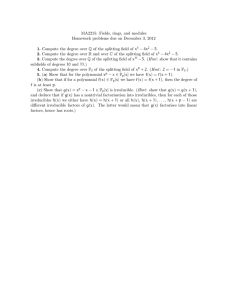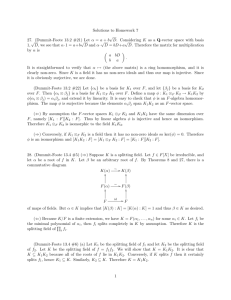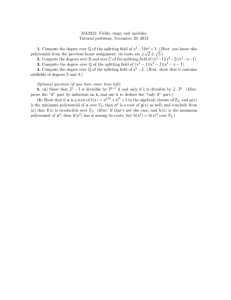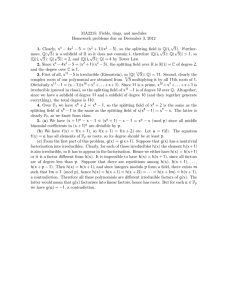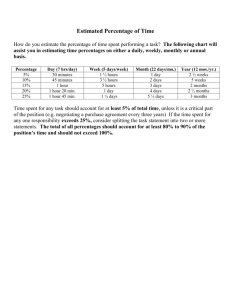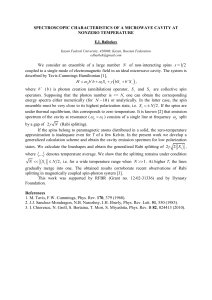Searching for feasible splitting strategies of controlled system islanding
advertisement
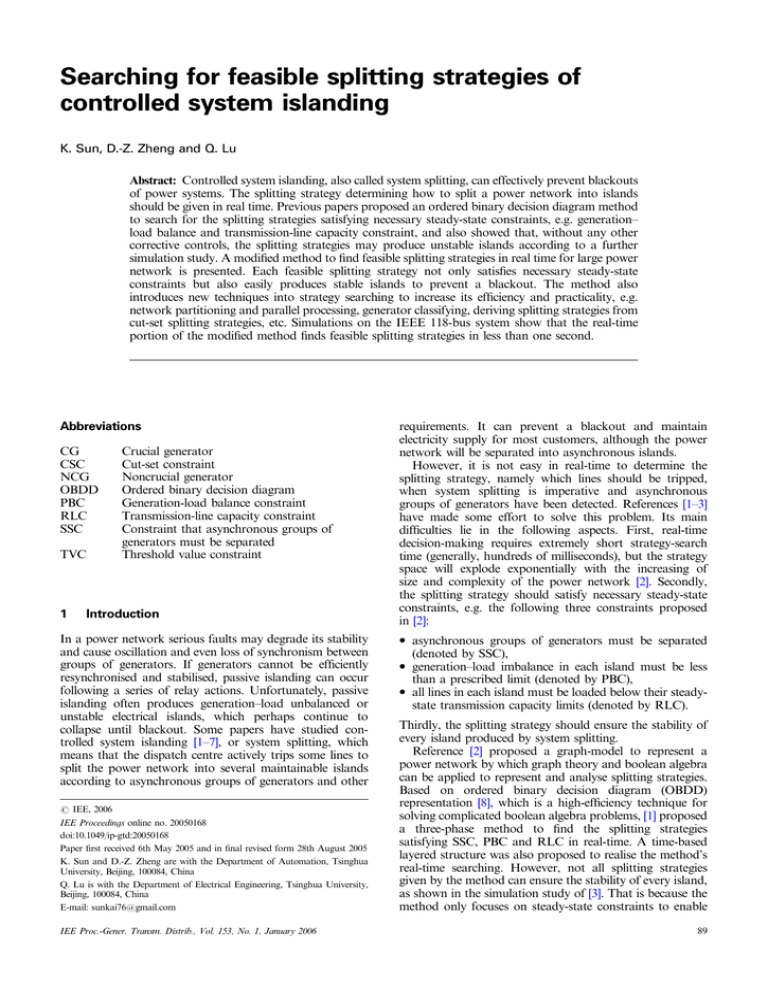
Searching for feasible splitting strategies of
controlled system islanding
K. Sun, D.-Z. Zheng and Q. Lu
Abstract: Controlled system islanding, also called system splitting, can effectively prevent blackouts
of power systems. The splitting strategy determining how to split a power network into islands
should be given in real time. Previous papers proposed an ordered binary decision diagram method
to search for the splitting strategies satisfying necessary steady-state constraints, e.g. generation–
load balance and transmission-line capacity constraint, and also showed that, without any other
corrective controls, the splitting strategies may produce unstable islands according to a further
simulation study. A modified method to find feasible splitting strategies in real time for large power
network is presented. Each feasible splitting strategy not only satisfies necessary steady-state
constraints but also easily produces stable islands to prevent a blackout. The method also
introduces new techniques into strategy searching to increase its efficiency and practicality, e.g.
network partitioning and parallel processing, generator classifying, deriving splitting strategies from
cut-set splitting strategies, etc. Simulations on the IEEE 118-bus system show that the real-time
portion of the modified method finds feasible splitting strategies in less than one second.
Abbreviations
CG
CSC
NCG
OBDD
PBC
RLC
SSC
TVC
1
Crucial generator
Cut-set constraint
Noncrucial generator
Ordered binary decision diagram
Generation-load balance constraint
Transmission-line capacity constraint
Constraint that asynchronous groups of
generators must be separated
Threshold value constraint
Introduction
In a power network serious faults may degrade its stability
and cause oscillation and even loss of synchronism between
groups of generators. If generators cannot be efficiently
resynchronised and stabilised, passive islanding can occur
following a series of relay actions. Unfortunately, passive
islanding often produces generation–load unbalanced or
unstable electrical islands, which perhaps continue to
collapse until blackout. Some papers have studied controlled system islanding [1–7], or system splitting, which
means that the dispatch centre actively trips some lines to
split the power network into several maintainable islands
according to asynchronous groups of generators and other
r IEE, 2006
IEE Proceedings online no. 20050168
doi:10.1049/ip-gtd:20050168
Paper first received 6th May 2005 and in final revised form 28th August 2005
K. Sun and D.-Z. Zheng are with the Department of Automation, Tsinghua
University, Beijing, 100084, China
Q. Lu is with the Department of Electrical Engineering, Tsinghua University,
Beijing, 100084, China
E-mail: sunkai76@gmail.com
IEE Proc.-Gener. Transm. Distrib., Vol. 153, No. 1, January 2006
requirements. It can prevent a blackout and maintain
electricity supply for most customers, although the power
network will be separated into asynchronous islands.
However, it is not easy in real-time to determine the
splitting strategy, namely which lines should be tripped,
when system splitting is imperative and asynchronous
groups of generators have been detected. References [1–3]
have made some effort to solve this problem. Its main
difficulties lie in the following aspects. First, real-time
decision-making requires extremely short strategy-search
time (generally, hundreds of milliseconds), but the strategy
space will explode exponentially with the increasing of
size and complexity of the power network [2]. Secondly,
the splitting strategy should satisfy necessary steady-state
constraints, e.g. the following three constraints proposed
in [2]:
asynchronous groups of generators must be separated
(denoted by SSC),
generation–load imbalance in each island must be less
than a prescribed limit (denoted by PBC),
all lines in each island must be loaded below their steadystate transmission capacity limits (denoted by RLC).
Thirdly, the splitting strategy should ensure the stability of
every island produced by system splitting.
Reference [2] proposed a graph-model to represent a
power network by which graph theory and boolean algebra
can be applied to represent and analyse splitting strategies.
Based on ordered binary decision diagram (OBDD)
representation [8], which is a high-efficiency technique for
solving complicated boolean algebra problems, [1] proposed
a three-phase method to find the splitting strategies
satisfying SSC, PBC and RLC in real-time. A time-based
layered structure was also proposed to realise the method’s
real-time searching. However, not all splitting strategies
given by the method can ensure the stability of every island,
as shown in the simulation study of [3]. That is because the
method only focuses on steady-state constraints to enable
89
fast decision-making, and it assumes that available
corrective control measures can stabilise each island after
system splitting. To improve the method, paper [3]
introduces a new constraint, ‘threshold value constraint’
(TVC), to exclude the splitting strategies that may cause a
large power-flow fluctuation and probably produce unstable
islands. Simulations show that if the threshold values of
TVC are properly selected, almost all splitting strategies
satisfying SSC, PBC, RLC and TVC can split the power
network into stable and maintainable islands. Currently
the method is still in a theoretical and trial stage. Before
applcation to actual power systems it requires further
study, e.g. improving its time performance for large power
networks, increasing the feasibility of splitting strategies (i.e.
preventing or decreasing unstable islands), considering
more practical factors of power systems, making better
use of the inherent structural characteristics of a power
network, introducing parallel techniques, etc.
This paper presents a modified method considering these
aspects. First, the modified method takes account of grid
loss to construct a zero-weight-sum graph-model of the
power network. Secondly, an offline network partitioning
technique is proposed to make parallel processors simultaneously start real-time strategy searching in all subnetworks.
Thirdly, generators are classified and differently treated
according to importance and capacity. Fourthly, a deriving
relation between splitting strategies is defined, which
suggests the order of strategy searching and checking.
Finally, TVC is introduced into the modified method to
exclude the splitting strategies that produce unstable islands.
Thus the splitting strategies satisfying SSC, PBC, RLC and
TVC are first considered in system splitting, and are
reasonably called ‘feasible splitting strategies’ in this paper.
Analysis and simulation results on the IEEE 118-bus system
show that, for arbitrarily assumed asynchronous groups of
generators, the modified method can give feasible splitting
strategies in real time.
2
Comparison between two methods
Each phase’s tasks of the original method and the modified
method are listed and compared in Table 1, where the
words in bold indicate their differences. A cut-set splitting
strategy is a cut set of the power network’s graph-model [2],
which only includes the lines contributing to separate
islands. More details are given in the following Section.
Offspring strategies of a splitting strategy is also defined.
begin
strategy space
phase-1
search
space
phase-2
splitting strategies
satisfying PBC and
SSC
phase-3
splitting strategies
satisfying PBC,
SSC and RLC
end
a
a cut-set
splitting strategy
satisfying
PBC and SSC
begin
strategy space
phase-1
3
phase-2
search
space 2
offspring
strategies
of a cut-set
splitting strategy
1
phase-3
feasible
splitting
strategies
end
b
Fig. 1
Comparison between search processes of two methods
a Original method
b Modified method
The idea of the original method is illustrated in Fig. 1a.
The larger white rectangle denotes the original strategy
space, whose size equals 2M if the power network has M
lines. The grey circle denotes the search space created by
phase-1, which is the actual searching scope of the original
method and whose size can be set much smaller by
preprocessing measures. The larger white square denotes the
set of all strategies satisfying PBC and SSC in the strategy
space, and the smaller grey one within it denotes the
strategies also satisfying RLC. The splitting strategies found
by the original method are denoted by the intersection of
the small grey square and the grey circle.
Figure 1b illustrates the modified method’s searching
process by a typical case. The larger white rectangle and the
grey circle have the same meanings as those in Fig. 1a.
Table 1: Comparison between original and modified methods
Phases
Original method
Modified method
1
Initialise parameters and decide search space by
preprocessing measures:
Construct graph-model
Initialise parameters and decide search space by
preprocessing measures:
Construct zero-weight-sum graph-model considering
grid loss
Combine nodes by areas and reduce irrelevant
nodes and edges
Partition power network into subnetworks
Classify generators
Combine nodes by areas and reduce irrelevant nodes and
edges in each subnetwork
2
Find all splitting strategies satisfying PBC and SSC in search
space by OBDDs
Find all cut-set splitting strategies satisfying PBC and SSC in
search space by OBDDs and parallel processing
3
Check RLC for splitting strategies until strategy satisfying
SSC, PBC and RLC found
Orderly check TVC and RLC for cut-set splitting strategies
and their offspring strategies until feasible splitting strategy
is found
90
IEE Proc.-Gener. Transm. Distrib., Vol. 153, No. 1, January 2006
Suppose that there are totally three cut-set splitting
strategies satisfying SSC and PBC in the search space, as
shown by the three black dots numbered 1–3. They can be
found by phase-2. The three sectors covering three black
dots denote all offspring strategies generated by three cutset splitting strategies. Assume that only strategies 1 and 2
have offspring strategies satisfying SSC, PBC, RLC and
TVC, and strategy 1 itself satisfies all the four constraints.
That situation is shown by two small squares in Fig. 1b,
which are just the feasible splitting strategies found in
phase-3. Compared with the original method, the modified
method’s searching scope is not limited in the search space
but covers all offspring strategies of the cut-set splitting
strategies found in phase-2. In Fig. 1b the actual searching
scope is the combination of the three grey sectors.
3
New characteristics of modified method
3.1
As discussed in [3], it is reasonable to focus only on the
backbone grid (e.g. 220 or 500 kV rating) of a large power
network when we study its splitting strategies. Meanwhile,
we use some equivalent generators to replace main power
plants. Thus in the rest of the paper, the power network
generally means the backbone grid of a large power
network.
A graph-model G(V,E,W) [2] depicts a n-bus power
network, where node set V ¼ {v1, y, vn} and edge set E
with elements eij(i o j), respectively, denote buses and
transmission lines, and node weight set W ¼ {w1, y, wn}
is determined by injected real powers from buses. A splitting
strategy can be depicted by an edge set S E. As an
example, Fig. 2 shows the IEEE 118-bus system’s graphmodel, where white dots are generator nodes denoting the
buses where generators are installed, and black dots are
load nodes denoting the other buses.
In the original method, node weights are defined as
injected real powers of corresponding buses. Since grid loss
exists, (1) does not hold, i.e. the graph-model is not zeroweight-sum. The modified method constructs a zero-weightsum graph-model G satisfying (1) in phase-1 to make better
use of the conclusions about zero-weight-sum graphs. For
instance, for the most common case of two-island splitting,
checking only the PBC of any one island is enough if G is
zero-weight-sum
n
X
wi ¼ 0
ð1Þ
i¼1
1
2
117
12
11
4
14
17
9
18
30
29
27
40 41
37
38
19
20 36
23
25
52
58
50
51
47
46
65
69
72
68
71
70
118 76
62
116
78
79
77 97
99
95 98
82
84
85
83
88
96
89
94
93
92
91 102
86
87
Fig. 2
81
80
75
106
100
105
104
109
IEEE 118-bus system’s graph-model
IEE Proc.-Gener. Transm. Distrib., Vol. 153, No. 1, January 2006
107
108
110
101 103
90
In fact, PBC, RLC and TVC do not demand too accurate
values of node weights, so in the modified method node
weights are calculated offline from typical generation and
load data and are updated online only if power flow
obviously fluctuates.
We do not consider reactive power balance in this paper
since real power balance is more crucial to system splitting.
Moreover, reactive power imbalance can be compensated by
local reactive power compensators in practice. The reactive
power balance problem in system splitting is not the emphasis
of this paper, but will be considered in our future research.
3.2
Deriving relation between splitting
strategies
We now study a kind of intrinsic deriving relation between
splitting strategies. Using it can obviously increase the
efficiency of the strategy search. Suppose that two splitting
strategies S1 and S2 (S1, S2 E) produce the same number
of islands, and there is S1 S2. We say S2 is an offspring
strategy of S1, and S1 is a parent strategy of S2. Obviously,
S1 is an offspring and parent strategy of itself. Moreover, if
S2 has k more elements (i.e. edges) than S1, we say S2 is a
k-level offspring strategy of S1 and, naturally, S1 is a k-level
parent strategy of S2. Since a splitting strategy usually has
many offspring strategies at the same level, we use ðSÞki
to denote the ith k-level offspring strategy of splitting
strategy S. Obviously, every cut-set splitting strategy has
only offspring strategies but no parent strategy except itself.
This analysis shows that every splitting strategy can be
derived from a cut-set splitting strategy. Therefore the
modified method’s phase-2 is focused on searching for cutset splitting strategies satisfying SSC and PBC.
To obtain cut-set strategies we introduce cut-set constraint (CSC): if a line is cut-off after system splitting, its
two terminal buses must belong to different islands. CSC
can be offline expressed by OBDDs in phase-2.
3.3
60
64 61
73
24
67
66
i¼1
59
63
49
74
26
56
57
43
35
55
54
53
45 48
22
114
115
42
44
21
31 113
32
28
33
34
13
7
10
39
15
6
5
8
i¼1
Then node vis weight wi can be determined by either (3)
or (4) to satisfy (1). Equation (3) subtracts grid loss
proportionately from all real power outputs; (4) adds grid
loss proportionately to all real power inputs
8 . P <P 1 P
Pi ; if Pi 40
i
loss ð3Þ
wi ¼
Pi 40
:
Pi ;
if Pi 0
8
< Pi ;
. P if Pi 0
wi ¼
ð4Þ
Pi if Pi o0
: Pi 1 þ Ploss Pi o0
Zero-weight-sum graph-model
3
First, estimate total grid loss Ploss by (2), where Pi , PG;i and
PL;i are, respectively, injected real power, real generation
power, and real load power of bus i
n
n
X
X
Pi ¼
ðPG; i PL; i Þ
ð2Þ
Ploss ¼
111
112
Network partitioning
Power system network partitioning [9] is an important
technique associated with the application of parallel processing. Its objective is to divide the whole power network
into subnetworks, which are simultaneously managed by
parallel processors. That can enhance the efficiency of
power system analysis, planning and operation.
Introducing a similar idea into the searching of splitting
strategies, the modified method offline partitions a large
power network into N subnetworks in phase-1. Consequently constraints SSC, CSC and PBC are rebuilt in each
subnetwork. In phase-2, the searching process for the
91
splitting strategies satisfying the three constraints is partitioned into N parallel procedures. That will greatly increase
the searching speed. Then N subnetworks’ cut-set splitting
strategies are incorporated to form the power network’s cutset splitting strategies. Finally, TVC and RLC are checked.
This Section mainly studies how to partition a power
network. The other problems are studied in Sections 3.4–3.6.
Generally a power network can be naturally partitioned
according to its structural characteristics or actual geographic areas. Here we propose a network-partitioning
approach based on graph theory to partition the power
network’s graph-model G into a number of subgraphs
denoting as many subnetworks. To avoid arduous analysis
work in incorporating all subnetworks’ splitting strategies,
we demand that all adjacent ones of the subgraphs jointly
cover an interface graph having as few load nodes as
possible. The approach has four steps
(i) In G(V,E,W), select an interface graph denoted by
G0(V0,E0,W0) which partitions the rest of G into K
subgraphs G1(V1,E1,W1)–GK(VK,EK,WK) as shown
in Fig. 3a. G0 should have as few load nodes as
possible. The following three conditions are satisfied:
first, V1 [ V2 [ ? [ VK [ V0 ¼ V and V1 \ V2 \ ? \
VK \ V0 ¼ f; secondly, if nodes vi and vj are both in
one of G0–GK, then edge eij connecting vi and vj, is also
in it; thirdly, there is no edge directly connecting any
two of G1–GK.
(ii) Construct G’s subgraphs GSNk(VSNk,ESNk,WSNk) (k¼
1K) satisfying VSNk ¼ Vk [ V0, and ESNk ¼ Ek [ E0 [
{all edges directly connecting GSNk with G0}. Thus GSN1–
GSN,K all contain the interface graph G0 as shown in
Fig. 3a.
(iii) Partition G0’s node weights into GSN1–GSN,K according
to the following rule: if a node vi of G0 has weight wi,
then its weights in GSN,1–GSN,K (denoted by wi1–wiK)
satisfy (5) and (6). Equation (6) makes each subgraph
still zero-weight-sum.
X
wik ¼ wi ; 8vi 2 G0
ð5Þ
GSN,2
G2
GSN,1
G0
G1
GK
GSN,K
a
GSN,2
GSN,1
G2
G 0,1
G1
G 0,2
G3
GSN,3
b
Fig. 3
Approach to network partitioning
a Key idea
b Feasible network partitioning of IEEE 118-bus system
k ¼ 1; ...; K
X
vl 2Vk
wl þ
X
wik ¼ 0; k ¼ 1 K
ð6Þ
vi 2V0
Table 2: Partitioning the IEEE 118-bus system
Subgraphs
G1
(iv) Recursively apply steps (a)–(c) to partition still complex
subgraphs. We assume that there are finally N
subgraphs GSNk(VSNk,ESNk,WSNk) (k ¼ 1N) and N0
interface graphs G0,1–G0,N0.
Node serial
numbers
1–48, 68–99, 101, 50–64,
102, 113–118
66, 67
As an example, Table 2 gives a possible way to partition
the IEEE 118-bus system’s graph-model into three subgraphs GSN,1–GSN,3 by two interface graphs G0,1 and G0,2, as
shown in Fig. 3b, where GSN,1 contains G1, G0,1 and G0,2,
GSN,2 contains G2 and G0,1, and GSN,3 contains G3 and G0,2.
An advantage of this partition is that every interface graph
only has generator nodes. Node weights w100,3, w49,2 and
w65,2 are first determined to make GSN,2 and GSN,3 a zeroweight-sum. Then w100,1, w49,1 and w65,1 are calculated by
3.4
w100;1 ¼ w100 w100;3 ;
w49;1 ¼ w49 w49;2 ;
w65;1 ¼ w65 w65;2
After the network partitioning, the largest subgraph G1 has
91 nodes, which may either continue to be partitioned or
be further reduced by the preprocessing measures in [1],
e.g. combining nodes by areas or reducing irrelevant nodes
and edges.
92
G2
G3
G0,1
G0,2
103–112
49, 65
100
Generator classifying
Some generators play more important roles than others in
power system operation and control, so it is not advisable to
treat all generators equally in splitting strategy searching.
The modified method offline classifies generators of each
subnetwork into two types: crucial generators (CGs): ones
that have large generation capacities or important functions
in operation and control, and non-crucial generators
(NCGs) which are the others. Separating a few NCGs
from the system generally does not affect its generation–
load balance and stability. For example, in the simulations
of [3], tripping several small-capacity generators does not
affect the success of system splitting. Accordingly NCGs are
treated as follows: if a NCG has adjacent load nodes it
may be directly islanded with approximately matched load
to form an island when necessary; otherwise it may be
tripped. Hence only CGs are considered by OBDD-based
algorithms [1] to search for splitting strategies. If a generator
IEE Proc.-Gener. Transm. Distrib., Vol. 153, No. 1, January 2006
lies in an interface graph it may be regarded as a NCG
of a subnetwork while it is classified as a CG of another
subnetwork. That depends on its weights in respective
subnetworks.
The preprocessing measure ‘combining nodes by areas’ in
[1] needs to be modified to reflect this kind of classifying.
Each subnetwork’s nodes are offline divided into generator
areas (NCG areas and CG areas) and load areas in phase-1.
A NCG area comprises a NCG node and approximately
matched load nodes if the NCG node has adjacent load
nodes; otherwise, the NCG area is the NCG node itself.
Since NCGs have a relatively weak influence on system
stability and generation–load balance, OBDD-based algorithms do not consider NCG areas in the searching of
each subnetwork’s splitting strategies. Then we judge
which island each NCG area belongs to when incorporating
all subnetworks’ splitting strategies. The other nodes are
divided into CG areas and load areas. Each CG area
contains a CG node, and may also contain some load nodes
if the CG node has adjacent load nodes. However, we do
not demand that these load nodes be matched since a CG
has usually a large generation capacity. Finally, each load
area has only load nodes. In the kth subnetwork, let PArea, k
denote the absolute upper limit of a load area’s weight sum,
which is recommended to satisfy (7) [1]
PArea; k DfPIsland
dmax
sf0 9
ð7Þ
where dmax is the maximum acceptable generation–load
imbalance in each island, PIsland is an estimated lower limit
of each island’s total real generation power, Df is a
prescriptive frequency-offset limit of each island, constant
s ¼ 2–5%, and f0 is the rating frequency. In general, dmax is
relatively large, but it is still possible that a single load
node’s weight slightly exceeds dmax. Thus the load node
itself should be regarded as a load area. In fact, this
situation seldom exists especially in a large power network.
In the power network’s PBC we need to prescribe an upper
limit (denoted by d) for each island’s weight sum, which
should satisfy d r dmax.
Here we make each generator area contain only one
generator node (perhaps corresponding to a power plant)
to enable the modified method to deal with any possible
asynchronous groups of generators. In practice, if some
generators always keep coherent after faults occur, they
may be put into the same generator area.
Then merge each of NCG areas, CG areas, and load
areas into an equal NCG, CG or load node. Thus a reduced
graph is formed from each subnetwork, where all NCG
nodes are ignored. The graph is further reduced by the
preprocessing measure ‘reducing irrelevant nodes and edges’
in [1]. Use GrSN;1 2GrSN ;N to denote the final N reduced
graphs which, respectively, correspond to the N subnetworks. For computer conditions similar to that used in the
following simulations, we recommend that nodes and edges
of each reduced graph should both be less than 40 to make
OBDD-based algorithms more efficient.
3.5
Splitting strategy searching by parallel
processing
As discussed in Section 3.2, the modified method’s phase-2
searches for cut-set splitting strategies satisfying SSC and
PBC in the searching space by OBDD-based algorithms.
The search process has two steps: first, find all cut-set
splitting strategies satisfying SSC and PBC in each of
GrSN ;1 2GrSN ;N , then incorporate them into the power
network’s splitting strategies satisfying SSC and PBC.
IEE Proc.-Gener. Transm. Distrib., Vol. 153, No. 1, January 2006
For each GrSN ;k let Ik be its node serial number set and
IG,k be its CG-node serial number set. Assume that all
CGs in the kth subnetwork are detected to separate into
NG,k asynchronous groups. Use IG;k;1 2IG;k;NG;k to denote
the sets of their corresponding node serial numbers in GrSN ;k .
Obviously
IG; k ¼ IG; k; 1 [ IG; k; 2 [ [ IG; k; NG; k
ð8Þ
Then GrSN ;k ’s CSC, PBC and SSC (denoted by CSCk, PBCk
and SSCk, respectively) are expressed in boolean functions
as follows.
First, from the meaning of CSC, we have
Y
CSCk ¼
hðAG;k Þij ! bk; i; j i
8i; j2IK ; ioj
h
Y
¼
ðAG;k Þij bk; i; j
i
ð9Þ
8i; j2IK ; ioj
where -, " and # respectively, denote logic operations
‘implication’, ‘or’, and ‘and’; AG,k is GrSN;k ’s adjacency
matrix. boolean variable bk,i,j ¼ (AG,k)ij ¼ (AG,k)ji (assume
ioj) equals 1 if nodes i and j are connected by an edge in
GrSN ;k ; otherwise, it equals 0; AG; k is defined by
def
AG;k ¼ I AG; k A2G; k ALG;k
ð10Þ
where I is the identity matrix, and L is the length of the
longest path in GrSN ;k ( for details, see [1]).
Secondly, referring to [1], we have
Y
PBCk ¼
hjðAG;k Þi W k j dk i
ð11Þ
i2IG ; k
SSCk ¼
Y
j ¼ 1; ...; NG; k
2
4
Y
3
ðAG; k Þi; iG; k; j 5
8i2IG; k; j
h
Y
ðAG;k Þl; iG; k; 1 ðAG;k Þl; iG; k; 2
8l=
2IG; k
ðAG;k Þl; iG; k; N
i
G; k
ð12Þ
where Wk is a column vector comprising GrSN ;k ’s all node
weights, is logic operation exclusive-or, iG,k,i 2 IG,k,i is an
arbitrarily selected serial number, and dk is a prescribed
absolute upper limit for each island’s weight sum in the kth
subnetwork. Considering the fact that an island may own
several parts lying in different subnetworks and their weight
sums may counteract when they are incorporated, we
allow dk to exceed d. After all subnetworks are incorporated, we use d to recheck each island’s weight sum. It is
recommended that d r dk r dmax.
Then, after the priority ordering of all boolean variables
bk,i,j is determined by the approach in [1], the OBDDs of
CSCk, PBCk and SSCk, denoted by D(CSCk), D(PBCk)
and D(SSCk), can be built and then compose one OBDD,
D(CSCk#PBCk#SSCk). Consequently GrSN ; k ’s all cut-set
splitting strategies satisfying SSC and PBC are quickly
found by OBDD-based algorithms.
The cut-set splitting strategies of subnetwork k (described
by GSN,k) can be determined from GrSN ; k ’s cut-set splitting
strategies by means of the relations between edges of GSN,k
and GrSN; k . Finally, the following steps will determine the
power network’s cut-set splitting strategies satisfying SSC
and PBC.
93
(a) For each NCG area, if there is an adjacent island
whose generators are synchronous with its NCG
(i.e. they are in one coherent generator group), we
reconnect the lines between them. Otherwise, isolate the
NCG area as an individual island or trip its NCG if
it has no load.
(b) Reconnect all synchronous and adjacent islands in the
power network.
(c) If an interface graph’s load nodes are contained by
different islands, then we put each load node into the
island where its weight is largest in absolute value. For
example, if load node vi’s weights in GSN,1–GSN,N are,
respectively, wi1–wiN, and 7wi,l7 Z 7wi,k7(8k ¼ 1–N), vi
will be put into GSN,k.
(d) For each splitting strategy check every island’s weight
sum. If it exceeds d the splitting strategy will be
excluded. This situation is caused by an increased
accumulation of all subnetworks’ generation–load
imbalances.
The islands produced by a cut-set splitting strategy are
perhaps greater than the detected asynchronous groups if
the following two situations occur. First, generators of a
coherent generator group lie in different subnetworks and
are finally put into different nonadjacent islands, which are
unable to combine to one island. Secondly, a NCG area
is isolated as an individual island. However, these do not
affect the feasibility of splitting strategies. Furthermore,
if we compare the splitting strategies obtained by parallel
processing and followed incorporation of subnetworks with
the splitting strategies obtained by a direct whole network
search, besides the fact that more islands may be produced
as mentioned, the former may be fewer in number if dk is so
small as to exclude some strategies satisfying PBC.
3.6
Two immediate conclusions are: a cut-set splitting strategy
and its all offspring strategies have equal A*() matrixes; for
certain GNet and GIsland, if a splitting strategy does not satisfy
TVC then its all offspring strategies does not satisfy TVC
either. Thus a natural idea is to first check TVC for each
cut-set splitting strategy.
Moreover, checking TVC is much simpler than checking
RLC since the latter needs power-flow calculation. Therefore the modified method checks RLC for a splitting
strategy only if TVC has been satisfied. Once RLC is also
satisfied the splitting strategy is given as a feasible splitting
strategy.
Accordingly, the modified method’s phase-3 is designed
as follows. Suppose that phase-2 finds NC cut-set splitting
strategies satisfying SSC and PBC (denoted by SC,1–SC,Nc).
A feasible splitting strategy can be given by the following
search procedure:
For each SC,i (i ¼ 1–NC), calculate A*(SC,i) and check
TVC. Only if TVC is satisfied, RLC is checked. If TVC
and RLC are both satisfied, output SC,i as a feasible
splitting strategy and stop the procedure.
If none of SC,1–SC,Nc is feasible splitting strategy,
continue the same checking in the last step for their
offspring strategies according to the ordering ‘from low
level to high level’, but ignore the splitting strategies
whose parent strategies do not satisfy TVC. Stop the
procedure until a feasible splitting strategy is found.
This search procedure is illustrated by the tree-like structure
in Fig. 4. In phase-3, NC parallel processors are used to
simultaneously start NC such searching procedures from NC
cut-set splitting strategies.
SC,i
Orderly checking TVC and RLC
TVC uses inequalities (13) and (14) to limit the disturbance degree caused by a splitting strategy S. Here
inequality (14) has been adapted to make TVC easily
checked by computer
P Pij
def
gNet ðSÞ ¼
eij 2S
P
Pk
GNet
ð13Þ
SC,i 's all 1-level
offspring strategies
SC,i 's all 2-level
offspring strategies
(SC,i )11
((SC,i )11)11
(SC,i )12
((SC,i )11)12
Pk 40; vk 2V
1
Pij C
Beij 2S;½A ðSÞi; il ¼ ½A ðSÞj; il ¼1
def
C GIsland ð14Þ
P
gIsland ðSÞ ¼ max B
A
@
l ¼ 1; ...; NI
Pk
0
P
Fig. 4 Tree structure for searching for feasible splitting strategy
(i ¼ 1BNC)
Pk 40; ½A ðSÞk; i ¼ 1
l
Pij is the real transmission power of line i–j; NI is the
number of the islands produced by S; i1–iNI are NI node
serial numbers selected from NI islands; A(S) is the
adjacency matrix of G after it is split by S; [A(S)]ij ¼ 1 if
(eij 2 E-S, or 0, otherwise; A*(S) can be calculated by the
same way as (10); GNet and GIsland are two selected threshold
values. Paper [3] gives an approach to selecting proper GNet
and GIsland.
For two splitting strategies S1 and S2, assume that S2 is
the ith k-level offspring strategy of S1, namely S2 ¼ ðS1 Þki .
Obviously, compared with S1, S2 trips k more lines but does
not produce one more island, so we easily obtain
94
A ðS2 Þ ¼ A ðS1 Þ
ð15Þ
gIsland ðS2 Þ gIsland ðS1 Þ
ð16Þ
4
4.1
Simulation
Simulation object and data
The performance of the modified method is checked on
the IEEE 118-bus system by a Pentium IV 2 GHz PC.
Simulation models and data are the same as [3]. Simulations
are performed based on a three-layer structure like that in
[1] and all tasks of the modified method are divided into
three time layers:
Offline layer: tasks are independent of online information
and are performed offline. They includes all tasks of phase-1
and partial tasks of phase-2, e.g. expressing CSCk by
OBDDs, etc.
Online layer: tasks depend on online generation and load
data and are performed with an interval of tens of minutes
IEE Proc.-Gener. Transm. Distrib., Vol. 153, No. 1, January 2006
Table 3: Node weights of IEEE 118-bus system
SN
10
12
25
26
49
61
65
66
69
80
87
89
100
103
111
wi (MW)
433.9
36.6
212.1
302.8
112.9
154.3
377.0
340.4
497.9
334.6
3.9
585.3
207.3
16.4
34.7
Pi (MW)
450.0
38.0
220.0
314.0
117.0
160.0
391.0
353.0
516.4
347.0
4.0
607.0
215.0
17.0
36.0
to an hour. They include most tasks of phase-2, e.g.
expressing PBCk by OBDDs, etc.
Real-time layer: contains the other tasks, which need to be
done in real-time after faults occur.
Simulations are performed according to the three time
layers in Sections 4.2–4.4.
4.2
Offline layer
Set GNet ¼ 0.3 and GIsland ¼ 0.1 by the approach in [3].
Then preprocess the power network. First, calculate total
grid loss Ploss ¼ 135.4 MW from (2). We use (3) to calculate
node weights. Table 3 gives the node weights wi different
from corresponding Pi. Partition the power network as
shown in Table 2 and Fig. 3b, and also partition the node
weights of G0,1 and G0,2 as w49; 1 ¼ 8:4; w49; 2 ¼ 121:3;
w65; 1 ¼ 377, w65; 2 ¼ 0; w100; 1 ¼ 20:5; w100; 3 ¼ 227:8:
Since most generators have a capacity larger than 150 MW,
let PIsland ¼ 150 MW. Assume that s ¼ 2% and DfM ¼ 2 Hz.
From (7), PArea;k dmax ¼ ð2150Þ=ð0:0260Þ ¼ 250 ðMWÞ.
Let PArea,1 ¼ PArea,2 ¼ PArea,3 ¼ 250 MW and d ¼ d1 ¼ d2 ¼
120 MW. The tasks for three subnetworks are described as
follows.
4.2.1
Subnetwork 1: In GSN,1 let generators 10, 25,
26, 49, 65, 69, 80, 89 be CGs and generators 12, 31 46, 87
and 100 be NCGs. Set CG, NCG and load areas as shown
in Table 4. The weight sum of each load area is not more
than 233 MW. The reduced graph GrSN ; 1 is given in Fig. 5a,
where white dots are CG nodes, black dots are load nodes,
grey dots are NCG nodes, and broken lines denote the
edges that are removed by ‘reducing irrelevant nodes and
edges’ and hence are not considered in phase-2. Table 4 and
Fig. 5a renumber all nodes of GrSN ; 1 by the approach in [1].
New serial numbers are used in building OBDDs. From (9)
h
i
Y
CSC1 ¼
ðAG; 1 Þij b1; i; j
8i; j2I1 ; ioj
4.2.2
Subnetwork 2: In GSN,2 let generators 54 and
65 be NCGs and the others be CGs. Set CG, NCG and
load areas as shown in Table 5. Then GrSN ;2 is given in
Fig. 5b. From (9)
h
i
Y
CSC2 ¼
ðAG; 2 Þij b2; i; j
8i; j2I2 ; ioj
20
14
18
16
Table 4: Areas in subnetwork 1
8
4
Area types
CG areas
Load areas
NCG areas
SN
1
Original nodes
88–97, 101, 102
Weight sum (MW)
47, 69
461.8
3
79–81, 98, 99
219.8
4
1–6, 8–11
135.2
5
65
377.3
6
26
303.0
7
25, 27–29, 32, 113–115
43–45, 48, 49
115.2
9
82–85
130.0
10
76–78, 118
233.0
11
68, 116
184.0
12
70–75
199.0
13
30
38
16
33, 34–37, 39
173.0
17
18–24
167.0
18
40–42
199.0
19
100
20
7, 12, 117
23
31
5
17
2
11
12
3
7
6
10
9
1
a
14
12
11
7
4
0.0
6
2
10
1
8
5
3
20.5
13
9
2.3
b
3.9
9.0
36.0
IEE Proc.-Gener. Transm. Distrib., Vol. 153, No. 1, January 2006
19
21
174.0
13–17
15
46
23
0.0
14
86, 87
13
5.3
8
22
15
135.7
2
21
22
Fig. 5
Reduced graph-models of subnetworks 1 and 2
a Subnetwork 1
b Subnetwork 2
95
4.3
Table 5: Areas in subnetwork 2
Area types
CG areas
Load areas
NCG areas
SN
Original nodes
Weight sum (MW)
1
66
340.4
2
49
121.3
3
61
154.3
4
59, 63
5
67
28.0
6
51–53, 58
70.0
7
50, 57
29.0
8
60
78.0
9
62
77.0
10
64
0.0
11
56
84.0
12
55
63.0
13
65
0.0
14
54
65.0
122.0
4.2.3
Subnetwork 3: Since GSN,3 has only 11
nodes, and generators 103 and 111 have much smaller
generation capacities than generator 100, let all the three
generators be NCGs and distribute loads to them to
form three NCG areas as shown in Table 6. When they
become asynchronous, some of lines 100-103, 103-104,
103-105, 103-110 and 109-110 are selected to directly
form cut-set splitting strategies of GSN,3. Then some
OBDDs about GSN,1 and GSN,2 can be built in offline layer,
e.g. DðCSC1 Þ; D½ðAG; 1 Þi; j (i 2 IG,1, j 2 I1), D(CSC2) and
D½ðAG; 2 Þi; j (i 2 IG,2, j 2 I2). Their time costs are listed in
Table 7.
Online layer
Node weights may be updated online according to
new generation and load data. Then D(PBC1) and
D(PBC2) are built online, whose time costs are also listed
in Table 7.
4.4
Real-time layer
After asynchronous groups are detected, D(SSC1) and
D(SSC2) are built at once. Then two final OBDDs,
D(CSC1#PBC1#SSC1) and D(CSC2#PBC2#SSC2)
are constructed from all available OBDDs. OBDD-based
algorithms will find all cut-set splitting strategies satisfying
PBC and SSC in the search space. Then a feasible splitting
strategy will be given in phase-3.
This process is simulated by a typical case. Set two
successive faults: at time t ¼ 0.0 s a three-phase fault
occurs near bus 100 at line 100-103; then another threephase fault occurs near bus 80 at line 77-80 after 0.05 s. The
two faults are both cleared at t ¼ 0.2 s after local relays trip
the two lines. As shown in Fig. 6, loss of synchronism and
voltage collapse occur, and generators separate into four
asynchronous groups {10, 12, 25, 26, 31, 46, 49, 54, 59, 61,
65, 66, 69}, {80, 89}, {100} and {87, 103, 111} within a short
time. Once they are detected, real-time layer tasks are
executed.
In phase-2 we have IG,1 ¼ {1, 2, 3, 4, 5, 6, 7, 8}, NG,1 ¼ 2,
IG,1,1 ¼ {1, 3} and IG,1,2 ¼ {2, 4, 5, 6, 7, 8}. Let iG,1,1 ¼ 1 and
iG,1,2 ¼ 2. Since GSN,2’s generators are synchronous,
IG,2 ¼ {1, 2, 3, 4}, NG,2 ¼ 1 and IG,2,1 ¼ IG,2. Let iG,2,1 ¼ 1.
From (12)
SSC1 ¼
Area types
SN
Original nodes
NCG areas
1
100, 104–109
2
103
3
110–112
Y
Y
ðAG;1 Þi; 1 8i2IG; 1; 1
Y
ðAG; 1 Þj; 2
8j2IG; 1; 2
ðAG; 1 Þl; 1 8l2I1 IG; 1
SSC2 ¼
Table 6: Areas in subnetwork 3
Y
AG; 1
l; 2
;
ðAG; 2 Þi; 1
8l2I2
Weight sum (MW)
55.9
16.4
72.3
After related OBDDs are built, OBDD-based algorithms
can quickly find the cut-set splitting strategies satisfying
SSC and PBC in GrSN ; 1 and GrSN ; 2 . In sub-network 3, the
only cut-set splitting strategy satisfying SSC and PBC is
{100-103, 103, 104, 103-105, 109-110}, which can be given
Table 7: Simulation times of all tasks in three time-layers
Layers
Tasks
Simulation times (s)
Each task
Offline layer
Build D½ðAG; 1 Þi; j (i 2 IG,1, j 2 I1) and D(CSC1)
Build
Online layer
Real-time layer
D½ðAG; 2 Þi; j (i 2 IG,2, j 2 I2) and D(CSC2)
4.66
0.05
Build D(PBC1)
16.1
Build D(PBC2)
0.1
Build D(SSC1) and find cut-set splitting strategies satisfying SSC and PBC
r
in GSN;
1
0.016
Build D(SSC2) and find cut-set splitting strategies satisfying SSC and PBC
r
in GSN;
2
o0.001
Calculate an A* (SC,i)
96
4.61
Each layer
16.1
o0.2
0.008
Check TVC for a splitting strategy
o0.0001
Check RLC for a splitting strategy
0.002
IEE Proc.-Gener. Transm. Distrib., Vol. 153, No. 1, January 2006
Table 8: Two feasible splitting strategies
4000
80,89
δ, deg.
3000
SC,1
2000
10
1000
Feasible splitting
strategies
Generators in
each Island
69-77, 68-81, 75-77,
75-118, 77-80, 85-86,
92-100, 94-100, 98-100,
99-100, 100-101,
100-103, 103-104,
103-105, 109-110
(total 15 lines)
80, 89
7.5
100
35.4
others
55.9
103, 111
0
− 500
Weight
sum (MW)
87,103,111
0
0.2
0.4
0.6
0.8
87
1.0
3.9
others
24.1
80, 89
41.5
100
35.4
t, s
a
65-68, 68-69, 77-80,
77-82, 78-79, 85-86,
92-100, 94-100, 98-100,
99-100, 100-101, 100-103,
103-104, 103-105, 109-110
(total 15 lines)
SC,2
80
76
89
f i , Hz
72
55.9
103, 111
68
100
87
3.9
24.9
others
64
others
1
60
2
3
87,103,111
0
0.2
0.4
0.6
0.8
117
12
11
4
14
1.0
t, s
b
6
5
8
7
17
18
30
9
1.2
15
13
29
10
37
38
20 36
35
52
58
50
47
67
65
69
72
68
62
71
116
78
118 76
70
26
79
77 97
Vi , pu
84
0.6
81
80
75
99
95 98
82
85
96
83
88
106
100
94
93
89
105
107
104
108
109
92
91 102
86
110
101 103
90
87
0.4
60
64 61
73
74
112
111
a
1
0.2
2
3
117
12
11
4
14
0
0.2
0.4
0.6
0.8
6
5
8
1.0
t, s
c
Dynamic curves of power network after faults are cleared
a Angular rotor swings of all generators
b All generator frequencies
c Voltages of all generator buses
39
15
33
34
13
7
17
9
18
30
29
10
Fig. 6
63
66
46
25
0
59
51
49
24
0.8
56
57
43
23
115
55
54
53
44
22
114
42
45 48
32
27
40 41
21
31 113
28
1.0
39
33
34
19
20 36
22
23
115
56
25
58
50
47
46
66
60
64
73
65
69
72
68
62
71
116
78
118 76
70
79
81
80
75
77 97
84
IEE Proc.-Gener. Transm. Distrib., Vol. 153, No. 1, January 2006
63
67
99
85
83
88
100
96
94
93
89
92
91 102
86
87
106
95 98
82
directly from Fig. 2 and Table 6. Consequently the cut-set
splitting strategies of three subnetworks are incorporated to
form the power network’ cut-set splitting strategies. Finally,
only two of them (denoted by SC,1 and SC,2) are found
satisfying PBC and SSC in phase-2.
In phase-3, SC,1 and SC,2 are found satisfying both
TVC and RLC, so they are feasible splitting strategies.
59
51
49
74
26
57
52
43
35
24
55
54
53
44
21
31 113
42
45 48
114
27
37
38
19
32
28
40 41
105
104
109
110
101 103
90
107
108
111
112
b
Fig. 7
Power network after it is split by SC,1 and SC,2
a SC,1 (five islands)
b SC,2 (five islands)
97
The online search time for them is less than 0.2 s.
They are shown in Table 8 and Fig. 7, where lines in
different islands are distinguished by different thicknesses. Each strategy produces five islands, which are
all found stable by transient stability simulations. Figure 8
gives dynamic responses of the system after it is split
by SC,1 at t ¼ 1.2 s (1 s after faults are cleared). Obviously system splitting makes all generators quickly stabilised.
Finally, the simulation time of each task in the three
layers are given in Table 7, which considers the effects of
parallel processing and neglects the communication time
among processors. Although different cases may have
different situations e.g. different numbers of cut-set splitting
strategies, all real-time layer tasks can generally be finished
within 1 s. Thus the modified method is able to find a
feasible splitting strategy in real time.
8000
80,89
6000
4000
δ, deg.
10
2000
others
0
87
103,111
− 2000
a
80
75
5
fi , Hz
70
80
89
Following the original method given in [1] for the splitting
strategies ensuring steady-state constraints, and the simulation study on these splitting strategies in [3], we have
proposed a modified method to real-time find feasible
splitting strategies which can produce maintainable and
stable islands. Compared with the original method the
modified method is more efficient and practical for large
power networks. Its performance has been shown by
simulations on the IEEE 118-bus system.
100
65
60
55
Conclusions
103 111
50
b
6
References
1.2
1.0
Vi , pu
0.8
0.6
0.4
0.2
0
0
1
2
3
4
t, s
c
Fig. 8
Dynamic responses of power network split by SC,1
a Angular rotor swings of generators
b All generator frequencies
c Voltages of generator buses
98
5
1 Sun, K., Zheng, D.-Z., and Lu, Q.: ‘Splitting strategies for islanding
operation of large-scale power systems using OBDD-based methods’,
IEEE Trans. Power Syst., 2003, 18, pp. 912–923
2 Zhao, Q.C., Sun, K., and Zheng, D.-Z. et al.: ‘A study of system
splitting strategies for island operation of power system: A two-phase
method based on OBDDs’, IEEE Trans. Power Syst., 2003, 18,
pp. 1556–1565
3 Sun, K., Zheng, D.-Z., and Lu, Q.: ‘A simulation study of OBDDbased proper splitting strategies for power systems under consideration of transient stability’, IEEE Trans. Power Syst., 2005, 20, (1),
pp. 389–399
4 Vittal, V., Kliemann, W., Ni, Y.-X., Chapman, D.G., Silk, A.D.,
and Sobajic, D.J.: ‘Determination of generator groupings for a
islanding scheme in the Manitoba Hydro system using the
method of normal forms’, IEEE Trans. Power Syst., 1998, 13,
pp. 1345–1351
5 You, H., Vittal, V., and Yang, Z.: ‘Self-healing in power systems: An
approach using islanding and rate of frequency decline based load
shedding’, IEEE Trans. Power Syst., 2003, 18, pp. 174–181
6 You, H.B., Vittal, V., and Wang, X.M.: ‘Slow coherency-based
islanding’, IEEE Trans. Power Syst., 2004, 19, pp. 483–491
7 Ahmed, S.S., Sarker, N.C., and Khairuddin, A.B. et al.: ‘A scheme for
controlled islanding to prevent subsequent blackout’, IEEE Trans.
Power Syst., 2003, 18, pp. 136–143
8 Bryant, R.E.: ‘Graph-based algorithms for boolean function manipulation’, IEEE Trans. Comput., 1986, C-35, pp. 677–691
9 Chang, C.S., Lu, L.R., and Wen, F.S.: ‘Power system network
partitioning using tabu search’, Electr. Power Syst. Res., 1999, 49,
pp. 55–61
IEE Proc.-Gener. Transm. Distrib., Vol. 153, No. 1, January 2006
